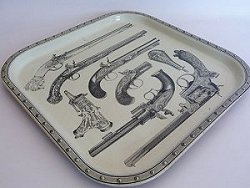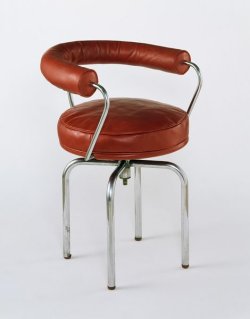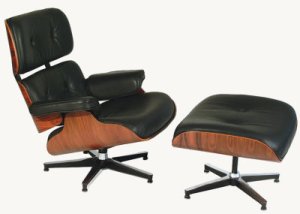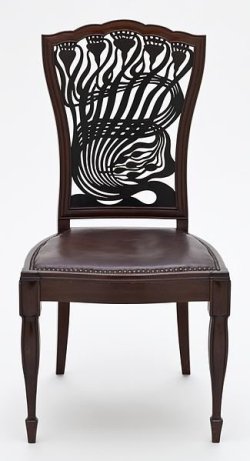With more and more modern furniture being bought at auction houses, contemporary is replacing repro as the next most desirable thing to antique.

Barcelona chair and ottoman, Mies van der Rohe, designed 1929. Source: Wikimedia Commons.
The wonderful thing about the Sixties was that in the midst of the sexual revolution and the popularisation of hallucinogenic drugs and the Beatles and Vietnam and psychedelic colours came a great revelation, spurred in part by Jackie Kennedy in America and in part by a new sensibility in Britain: that it was OK to like trendy new things and contemporary design. It’s taken a while for people to be entirely at ease with this new attitude, but reputable people are busy collecting pieces from the Thirties which their grandmothers would never have tolerated for a minute, acquiring pieces from the Sixties at which even Jackie Onassis might balk, and, if they are truly adventurous, buying pieces from the Eighties of which no one has yet had time to disapprove. The idea that the contemporary is vulgar and second-rate is finally on the way out; some people now actually prefer contemporary design to eighteenth-century design, but everyone has opted vigorously against the fake antique as grossly vulgar and middle-class. So even while Chippendale remains fabulously desirable, reproduction Chippendale is now biting the proverbial dust, and people of taste are turning to the present as they find it increasingly difficult to afford the past.
The auction houses have leapt to the bait of the new taste in modern furniture. Christie’s now has regular sales of modern furniture and decorative arts, including an annual sale of twentieth-century British design. The sale, which takes place in late January, includes pieces from the Arts and Crafts Movement of the end of the last century and pieces designed by people who are still alive and who come to see their own work fetch higher prices than it did in the showroom. The buyers are younger than the buyers at most Christie’s sales, people in the neighbourhood of 40, though some of them are much younger, people who aren’t afraid of investing with the blindness of little hindsight. Some of them want to furnish houses; some of them are dealers; others are serious collectors of twentieth-century design. In the catalogues for these sales, every object is illustrated, so that people who are not deadly earnest about collecting can flick through and pick out odds and ends that grip them and place telephone or telex bids.

Guns tray, Piero Fornasetti. Photo by Jay Kaye.
Their wisdom is not only aesthetic. “If you’re aware of the market,” explains Paul Greenhalgh, the expert in charge of the Christie’s sales, “I think it’s easy to buy a table now that will appreciate in value. Right now it’s big to get things from the Fifties and Sixties. If you’d bought Fornasetti dinner plates with designs of printed matter on them in the Fifties, you’d have done very well. Six of them just sold for £1,400. I want to persuade young people setting up house to buy something by an artist and not something from a department store that will more often than not depreciate in value.” And of course the prices are more like the prices for furniture in department stores than like prices for antiques at auction at Christie’s.
The sales have some very recent material in them, and there are those who have said that the appearance of such pieces in an auction at somewhere so estimable as Christie’s has helped to form the reputations of the artists, but Paul Greenhalgh resists this idea. “People are always looking out for new movements. But that’s not something that Christie’s can do. We’re just acting as agents. If someone wants to sell a work by a contemporary artist, that artist must have had a one-man exhibition; he has to be part of the system already.” It’s a funny system, and determining who is part of it can be tricky. To be a real member, an artist would need to have had a one-man exhibition, to appear in important collections like the Saatchis’, and to have a gallery behind him with their publicity machine.”
The growing acceptance of contemporary design is a factor not only in the auction and private sectors, but in the museum world as well. “People bought contemporary furniture at the end of the last century,” explains Clive Wainwright, who is in charge of acquiring twentieth-century furniture for the Victoria & Albert Museum, “and so did we. This museum had a grant to buy things at the 1851 exhibition, and we bought much of our Victorian collection then.” In the early part of the twentieth century, this began to change, and nothing contemporary was bought in the Twenties and Thirties. In the Fifties the V&A began to buy contemporary things again, and on a regular basis.

Siège tournant, Le Corbusier, designed 1928. Victoria & Albert Museum.
How do they decide? How does one recognise a landmark of design? “You see something and you know you want it and you feel you ought to have it,” Clive Wainwright explains. “But you’ve never seen one before. And you don’t know why you want it. So you acquire it and you get it back to the museum and you think, “Why did I want one of those?” And you write a label for it and you put it under a spotlight in a gallery and you wait to see if other museums acquire the same thing. And sometimes they do.” But sometimes, of course, they don’t. “We’ve acquired things from people who seem terribly promising and who’ve afterwards sunk without a trace. You just have to wait and see.”
The idea of the one-of-a-kind piece, designed and created by a single artist, is really quite a recent one, though a large part of its appeal is that people think of it as perfectly ancient. “In the pre-William Morris world,” explains Clive Wainwright, “there were people who designed things and people who made things and they were very rarely the same people. Chippendale did not design most of the things he made. Then you get into the whole crafts mentality when you think that if something is beautifully made then it’s beautiful. People somehow think that if you spend long enough on something and you make it absolutely exquisitely, it must be well designed. They’re wrong.”
The whole principle of one-off designs, of individual pieces individually made, of artist-craftsmen, is one that appeals in England and in the United States much more than it does in the rest of Europe. Many people would rather have a great work of design which is tested, tried and true than an individual piece with which no one has ever lived before. And many people, especially in Germany, would prefer a piece of up-market mass-produced furniture with an exact degree of status and a known price to a piece their neighbours will be unable to evaluate. Christie’s sells important pieces of mass-produced furniture in its twentieth-century sales, though its emphasis is on artisan pieces, the V&A is collecting far more mass-produced work than craftwork.
“Fine design is the key thing,” says Clive Wainwright. “Whether there are 10,000 of this thing or just one is utterly irrelevant. And then there’s a level at which the mass-produced/one-off line is a false one. Someone who has only one idea can make virtually the same piece of one-off furniture, two per year, for twenty years. That might as well be mass-produced.” since Le Corbusier, since, indeed, Walter Benjamin’s important essay “Art in the Age of Mechanical Reproduction,” it has been difficult for designers to justify doing single pieces, and so many of the true designers in the true spirit of the twentieth century have turned to mass-production. “If you’re a really fine designer,” says Clive Wainwright, “I think you want to see your design everywhere. I think the exciting thing is to design a piece of furniture which becomes a universal, like the Barcelona chair or the siège tournant or the Eames chair with ottoman.” Paul Greenhalgh would sell any of these at auction; early versions of them are great collectors’ items.

Lounge chair and ottoman, Charles and Ray Eames, designed 1956. Source: Wikimedia Commons.
Of course many of these pieces have been in production for years. The Eames chair, by Charles Eames, has been made without a break since 1958. “But it’s naïve to think that the one you buy now is the same as the one you found at the beginning,” says Clive Wainwright. “If you look at a 1959 Eames chair and you look at the present one, there are lots of differences; the manufacturer has improved it, as they consider it, in all sorts of little ways. Things like the pads they stand on, quite probably the filing of the cushions, and possibly the varnish are all different. It may an improvement, but it’s not the same animal as it was in 1959.”
The V&A would like ideally to have pieces in several stages of production: an early Antelope chair, a middle-period Antelope chair, and a late Antelope chair. Most private collectors simply don’t have room for three versions of the same chair, so the thing to go for is the early one, which increases in value most dramatically. Many pieces that one would think had been in continuous production — like Mies van der Rohe’s Barcelona chair and Le Corbusier’s siège tournant — were in fact made in small numbers and then dropped and then brought back in the Sixties. So the copies are in effect no more valid than copies of Georgian bureaux. “It’s a cop-out to buy yet another pair of Le Corbusier lounge chairs and put them in a flat in Wapping,” says Clive Wainwright. “The thing to do is to identify major pieces of design that are likely to go on being produced but that are now in their early stages of production.” If those pieces are produced on into the future, the earliest states will be collectors’ items; if they are discontinued, they will be worth even more.

Silver and ebony tea pot, Christopher Dresser, designed ca. 1879. Source: Wikimedia Commons.
“Collect Christopher Dresser,” counsels Paul Greenhalgh, “and Charles Rennie Mackintosh and William Morris, of course. English things from the beginning of the century, and then Porter in Belgium, and French art nouveau. In the deco period, one looks to Paris. After that, there’s modernism running alongside deco, and that’s in Germany in the Bauhaus and in Austria in the wiener Wekstade. After the War, there’s Italy, and more of Italy in the Sixties, and America in the Sixties as well. In the seventies there’s Italy again, but it’s a bit of a dead period.” Clive Wainwright adds Scandinavia to the list, especially for landmarks of mass-produced furniture. “It was the only place in the Thirties, and then came back in the Fifties, and then was eclipsed until the late Seventies, when brilliant people like Yrjo Kukkupuru, who had done moulded fibreglass twenty years earlier, suddenly moved back to wood.”
As for right now — Clive Wainwright goes to the degree show at the Royal Collection of Art every year, and discovers people there; John Makepeace, the master craftsman of Britain, has a school at Parnham which produces wonderful artisans who can sometimes design. The V&A bought a piece by Rupert Williamson at the RCA show a few years ago, and he has since risen to prominence in the field; they also recently acquired a piece by Parnham student Vereina Priedt, who is now doing very fine works of design in Germany. “Collecting living artists has a lot to do with how long they live,” Clive Wainwright points out. “We’re buying design from Italy by Magistretti now and we were buying his earlier designs twenty years ago.”
Paul Greenhalgh sketches the design patterns of the Eighties, describing what may be in auctions five or ten years hence: “There’s a very fine knife-edge for some movements between innovation and kitsch. One can already see a difference between the early Eighties and the late Eighties. In the early Eighties everything was rather joky — very bright colours and the fun of post-modernism and all rather kitsch in a way. I think of the late Eighties as being much more realistic. A great interest in metal furniture and glass furniture and in metal and glass together. It has picked up on the brutalism that was in architecture in the late Sixties or early Seventies; there’s not so much fantasy now as there was at the beginning of the Eighties.”
“There’s something new all the time,” says Clive Wainwright. “Look at this,” he says, and proffers a photograph of a neo-classical wooden desk of exquisite proportions by someone called Nick Allen, a piece that looks almost of another era but in which there is too much whimsy for a real antique. “It’s beautiful,” he says simply — and indeed it is.

Chair, Arthur Heygate Mackmurdo, designed ca. 1883. Exhibited by the Los Angeles County Museum of Art. Source: Wikimedia Commons.











